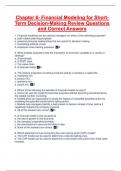Chapter 6- Financial Modeling for Short-
Term Decision-Making Review Questions
and Correct Answers
1. Financial modeling can be used by managers for which of the following purposes?
a. staff rotation planning purposes.
b. analyzing financial relationships that are useful for decision making.
c. forecasting political unrest.
d. employee cross-training purposes. ✅B
2. What enables analysts to test the interaction of economic variables in a variety of
settings?
a. A benchmark
b. A PERT chart
c. The value chain
d. A financial model ✅D
3. The relative proportion of various products sold by a company is called the
a. marketing mix.
b. product mix.
c. operating mix.
d. output mix. ✅B
4. Which of the following are benefits of financial models to users?
a. Users can use the model for business purposes without becoming overwhelmed by
the related number crunching.
b. Models allow an organization to study the impact of a possible business action by
reviewing the potential results before taking action.
c. Models help managers identify a bad project or decision ahead of time, before it
negatively impacts the company involved.
d. All of the answers are correct. ✅D
5. A financial model is only as good as
a. the rate of growth in the economy.
b. the company's operating leverage.
c. the assumptions it uses and the data it uses.
d. None of the answers are correct. ✅C
6. Which statement is true concerning the cost-volume-profit (CVP) model?
a. The CVP model can be used to determine a desired selling price.
b. The CVP model can be used to determine a new break-even point when fixed costs
increase.
,c. The CVP model can be used to determine a new break-even point when variable
costs decrease.
d. All of the answers are correct. ✅D
7. A basic financial model that summarizes the effects of volume changes on an
organization's costs, revenue, and income is the
a. total revenue-total cost model.
b. break-even model.
c. cost-volume-profit model.
d. program, planning, and profit model. ✅C
8. The CVP model is one example of a financial model that can be used to calculate
which of the following?
a. required selling price and conduct sensitivity analysis.
b. new break-even points and calculate multiple break-even points.
c. target profit points and compare alternatives.
d. All of the answers are correct. ✅D
9. How does cost-volume-profit analysis allows management to determine the relative
profitability of a product?
a. By highlighting potential bottlenecks in the production process.
b. By keeping fixed costs to an absolute minimum.
c. By determining the contribution margin and projected profits at various levels of
production.
d. By assigning costs to a product in a manner that maximizes the contribution margin.
✅C
10. How might a company with a negative contribution margin reach the break-even
point?
a. Increase sales volume.
b. Decrease sales volume.
c. Decrease fixed costs.
d. Decrease variable costs. ✅D
11. How can a company increase their break-even point?
a. Decrease fixed costs.
b. Increase the contribution margin ratio.
c. Increase variable costs.
d. Decrease in variable costs. ✅C
12. If a company's sales price per unit is $100, variable costs per unit are $60, and fixed
costs for the year are $600,000. How many units must the company sell to break even?
a. 36,000
b. 22,500
c. 15,000
, d. 9,000 ✅C
13. If a company has variable costs of $40 per unit, fixed costs of $3,000 per month and
sells its product for $50, how many units must it sell to break-even?
a. 300
b. 250
c. 100
d. 50 ✅A
14. Calculate break-even when a company's selling price per unit is $15, variable costs
per unit are
$8, fixed costs for the year are $70,000.
a. 8,750 units
b. 4,667 units
c. 7,000 units
d. 10,000 units ✅D
15. A company currently breaks even at 1,000 units. Its fixed costs are $40,000 and its
variable costs are $10 per unit. What is the product's selling price per unit?
a. $100
b. $ 50
c. $ 35
d. $ 25 ✅B
16. A company's selling price is $12 per unit, variable cost is $3 per unit, and fixed costs
are
$25,000. What is the break-even point in sales dollars?
a. $53,333
b. $44,444
c. $33,333
d. $ 1,333 ✅C
17. A company produces two products, A and B. A sells for $16 and has variable costs
of $10. B sells for $12 and has variable costs of $8. Fixed Costs for the period are
$35,000. An equal number of A and B units are sold. At the break-even volume, how
many units of A will be sold?
a. 14,000
b. 8,750
c. 7,000
d. 3,500 ✅D
18. A company produces two products, A and B. A sells for $16 and has variable costs
of $10. B sells for $12 and has variable costs of $8. Fixed Costs for the period are
$35,000. Normally four units of A are sold for every two units of B units. How many units
of B must be sold if the company expects profits of $50,000?
a. 15,947




